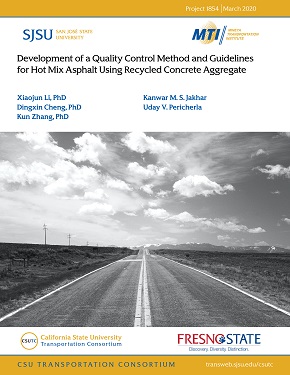- 408-924-7560
- mineta-institute@sjsu.edu
- Donate
Development of a Quality Control Method and Guidelines for Hot Mix Asphalt Using Recycled Concrete Aggregate
Each year, about 122 million tons of aggregates, a major structural component of pavement, are used in asphaltic mixtures in pavement construction. At the same time, aging U.S. infrastructure produces around 200 million tons of demolition waste each year, half of which is concrete debris. Therefore, introducing recycled concrete aggregate (RCA) as hot mix asphalt (HMA) aggregate could not only relieve the disposal pressure but also result in considerable reductions in cost, energy usage, and greenhouse gas emissions in the paving industry.
A limited number of studies regarding the use of RCA to substitute virgin aggregate in HMA (RCA-HMA) exist. More importantly, the findings reveal discrepant or even contradictory results, regarding the effects of RCA on almost all the volumetrics and performance indicators of RCA-HMA. Because RCA is different from virgin aggregate, as RCA particles are at least partially covered by a residual cement mortar (RCM) layer, the attached RCM in RCAs from different concrete sources could significantly differ in terms of content, porosity, and distribution on the RCA surface.
This study aims to determine the characteristics of RCA and RCM, such as RCM content, specific gravity, and absorption, and to evaluate their effects on the volumetrics and performance indicators of RCA-HMA. This research evaluates the variation in the properties of RCA and RCM obtained from different sources and their effects on RCA-HMA’s performance. The research revealed the properties of RCA from different sources vary significantly. It is insufficient to predict the volumetrics and performance of RCA-HMA using only the information of RCA, such as RCA replacement rate and gradation. Information pertaining to the RCM’s properties, such as the RCM content, specific gravity, and absorption, is critical for the prediction of the RCA-HMA properties, including optimum binder content (OBC), voids in mineral aggregate (VMA), voids filled with asphalt (VFA), resistance to permanent deformation, and moisture damage susceptibility. The results of this i vestigation can help to ensure reliable performance of RCA-HMA in practice by controlling the properties of RCM in the RCA.
XIAOJUN LI, PhD
Dr. Xiaojun Li is assistant professor at Department of Civil & Geomatics Engineering, California State University, Fresno. Dr. Li’s research focuses on sustainable pavement materials, and on developing sustainable solutions for transportation, with emphasis on recycled materials, industrial/municipal waste/byproducts, bio-materials, and composite materials. Dr. Li’s research goal is to achieve more sustainable transportation infrastructure that satisfies the concerns of the economy, environment, and society.
DINGXIN CHENG, PhD, PE
Dr. DingXin (Ding) Cheng is a professor of the department of civil engineering at the California State University, Chico, director of the California Pavement Preservation (CP2) Center, and the director of the Tire Derived Aggregate Technology Center. He has worked actively with the CP2 Center since he joined the department of civil engineering of CSU Chico in 2006. He obtained his PhD in the areas of pavement materials and transportation from Texas A&M University in College Station, Texas in 2002. He worked in private industry for Parsons Brinckerhoff in Houston, TX before joining the Chico State University. He has extensive experiences in Hot Mix Asphalt (HMA) materials and pavement preservation on both asphalt and concrete pavements. He has more than 55 peer-reviewed publications related to pavement materials and preservation in Transportation Research Board, AAPT, ASCE, and other conferences. Ding has co-managed or managed more than $7 million research projects funded by California Department of Transportation (Caltrans), California Department of Resources Recycling and Recovery (CalRecycle), Metropolitan Transportation Commissions (MTC) of San Francisco Bay Area, and other agencies and industry participants.
KUN ZHANG, PhD
Dr. Kun Zhang is an Assistant Professor at the Department of Civil Engineering at California State University, Chico and Senior Pavement Researcher at California Pavement Preservation Center. His featured research interests and efforts focus on advanced numerical modeling for particulate systems processing and mechanical behaviors of geo and pavement Materials, including the use of computational fluid dynamics (CFD), discrete element method (DEM), and finite element method (FEM); and optimization recycling of waste pavement materials and industrial by-products in asphalt materials, including RAP/RAS, waste carbon fiber composite materials, recycled concrete aggregate, and waste cooking oil for bio-binder development, etc. He has served as PI/Co-PI for several projects funded by various agencies, including FHWA, DOTs, and industrial companies.
-
Contact Us
San José State University One Washington Square, San Jose, CA 95192 Phone: 408-924-7560 Email: mineta-institute@sjsu.edu






